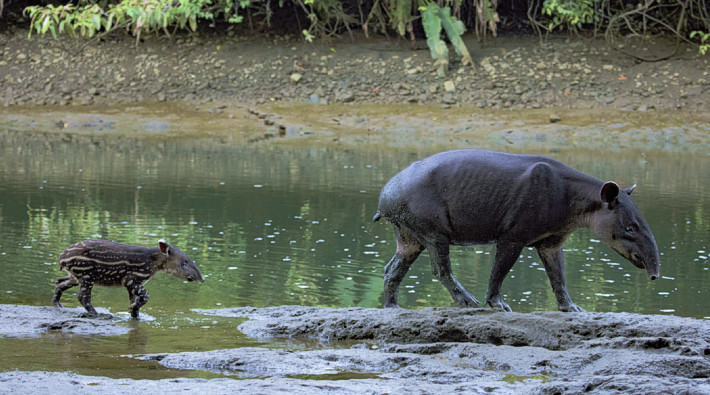Remarkable maternal behavior of Baird’s tapir (Tapirus bairdii) at Corcovado National Park, Costa Rica
DOI:
https://doi.org/10.31687/SaremNMS23.8.3Keywords:
calf, mammal, Perissodactyla, Sirena River, swimmingAbstract
Baird's tapir (Tapirus bairdii) prefers habitats with bodies of water in the vicinity. On 3 December 2021, we recorded a female tapir and its calf crossing the Sirena River, Corcovado National Park, southwestern Costa Rica. The calf followed its mother when it entered the river; however, in the deepest part of the river, the mother submerged for a few seconds, and when it emerged, the calf was on top of her, continuing to move this way until they crossed the river. This behavior, therefore, could be a local adaptation to protect calves from predators such as crocodiles and bull sharks.
References
Daly, R., P. W. Froneman, & M. J. Smale. 2013. Comparative feeding ecology of bull sharks (Carcharhinus leucas) in the coastal waters of the southwest Indian Ocean inferred from stable isotope analysis. PLoS One 8:e78229. https://doi.org/10.1371/journal.pone.0078229.
Endo, H., M. Yoshida, T. S. Nguyen, Y. Akiba, M. Takeda, & K. Kudo. 2019. Three-dimensional CT examination of the forefoot and hindfoot of the hippopotamus and tapir during a semiaquatic walking. Anatomy, Histology, Embryology 48:3–11. https://doi.org/10.1111/ahe.12405.
Estupiñán-Montano, C., J. F. Estupiñán-Ortiz, L. Cedeño-Figueroa, F. Galván-Magaña, & C. J. Polo-Silva. 2017. Diet of the bull shark, Carcharhinus leucas, and the tiger shark, Galeocerdo cuvier, in the eastern Pacific Ocean. Turkish Journal of Zoology 41:1111–1117. https://doi.org/10.3906/zoo-1610-31.
Foerster, C. R., & C. Vaughan. 2002. Home range, habitat use, and activity of Baird's tapir in Costa Rica. Biotropica 34:423–437. https://doi.org/10.1111/j.1744-7429.2002.tb00556.x.
García, M., et al. 2016. Tapirus bairdii. The IUCN Red List of Threatened Species 2016:e.T21471A45173340. https://doi.org/10.2305/IUCN.UK.2016-1.RLTS.T21471A45173340.en.
Gilmore, M. 2007. Tapir behavior: an examination of activity patterns, mother-young interactions, spatial use, and environmental effects in captivity on two species (Tapirus indicus and Tapirus bairdii). M. Sc. Thesis. Oklahoma State University.
ICF (Instituto de Conservación Forestal). 2011. Plan nacional para la conservación del danto (Tapirus bairdii). Departamento de Vida Silvestre / Instituto de Conservación y Desarrollo Forestal, Áreas Protegidas y Vida Silvestre – Proyecto Ecosistema – Grupo de Especialistas en Tapires SSC/UICN, Tegucigalpa, Honduras.
Lira, I., I. J. March, & E. Naranjo. 2014. Baird's tapir. Mammals of Mexico (G. Ceballos, ed.). Johns Hopkins University Press, Baltimore.
Medici, E. P. 2011. Family Tapiridae (Tapirs). Handbook of the mammals of the world. Vol 2. Hoofed mammals (D. E. Wilson & R. A. Mittermeier, eds.). Lynx Edicions, Barcelona.
Mora, J. M. 2000. Mamíferos silvestres de Costa Rica. Editorial Universidad Estatal a Distancia, San José.
Naranjo, E. J. 2009. Ecology and conservation of Baird's tapir in Mexico. Tropical Conservation Science 2:140–158. https://doi.org/10.1177/194008290900200203.
Naranjo, E. J. 2019. Tapirs of the Neotropics. Ecology and conservation of tropical ungulates in Latin America (S. Gallina-Tessaro, ed.). Springer Nature, Cham. https://doi.org/10.1007/978-3-030-28868-6_18.
Nowak, R. M. 1999. Walker’s mammals of the world. 6th edition. Johns Hopkins University Press, Baltimore, Maryland.
Reid, F. A. 2009. A field guide to the mammals of Central America & southeast Mexico. 2nd edition. Oxford University Press, New York.
Schank, C. J., et al. 2017. Using a novel model approach to assess the distribution and conservation status of the endangered Baird's tapir. Diversity and Distributions 23:1459–1471. https://doi.org/10.1111/ddi.12631.
SINA C (Sistema Nacional de Áreas de Conservación). 2017. Lista Oficial de especies en peligro de extinción y con poblaciones reducidas y amenazadas. R-SINAC-CONAC-092-2017. La Gaceta #187, Alcance #239, San José, Costa Rica.
Tuma, R. E. 1976. An investigation of the feeding habits of the bull shark, Carcharhinus leucas, in the Lake Nicaragua–Rio San Juan system. Investigations of the ichthyofauna of Nicaraguan lakes (T. B. Thorson, ed.). School of Life Sciences, University of Nebraska-Lincoln.
Vaughan, C., & M. A. Rodríguez. 1997. Managing beyond the borders: the Costa Rican National System of Conservation Areas (SINAC). Principles of conservation biology, 2nd edition. (G. K. Meffe & C. R. Carroll, eds.). Sinauer Associates, Sunderland, Massachusetts.
Vaughan, C. 1981. Parque Nacional Corcovado. Plan de Manejo y Desarrollo. Universidad Nacional, Heredia, Costa Rica.

Downloads
Published
How to Cite
Issue
Section
License
Copyright (c) 2023 Dionisio Paniagua , José M. Mora

This work is licensed under a Creative Commons Attribution-NonCommercial 4.0 International License.

